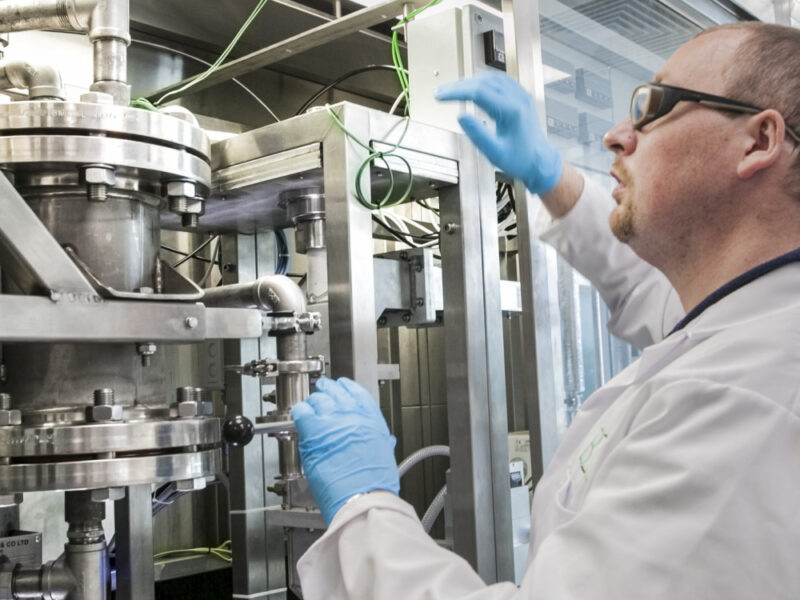Novel valorisation routes of red seaweeds for oligosaccharide and protein extraction

- Project lead
- Federico Sabbadin
- Institute
- University of York
Summary:
Red seaweeds (or red macroalgae) have been consumed for thousands of years as part of the human diet and are commonly found and harvested along Great Britain’s western coast. These organisms are rich in diverse biomolecules, including proteins, polysaccharides, pigments, fatty acids, vitamins, minerals, and phenolic compounds, with wide-ranging medical and industrial uses. Red algal polysaccharides (e.g. sulfated polysaccharides and xylans) and pigments exhibit antioxidant, anti-inflammatory, immunomodulatory, anti-cancer and prebiotic properties. Furthermore, red seaweeds contain high levels of protein, in some cases rivalling conventional protein rich foods such as fish, eggs and soybean.
Efficient extraction of valuable compounds from red algae is challenging due to their viscous cell wall polysaccharides. Carbohydrate Active Enzymes (CAZys), including glycoside hydrolases, lyases, esterases and lytic polysaccharide monooxygenases (LPMOs) naturally break down these polysaccharides. Complete deconstruction of algal biomass, however, requires synergistic physico-chemical and enzymatic treatments with industrial scalability, which are currently lacking.
The proposed project aims to combine microwave-assisted extraction techniques with tailored enzymatic treatments to process red algal biomass, thereby producing high-value oligosaccharides and protein concentrates for various applications. This project draws in expertise from leading academics as well as industrial and research partners, and will open up new opportunities for commercialisation of red seaweed biomass derivatives.
Aims:
The project had four key objectives:
- Perform compositional analysis of polysaccharides from red seaweed
- Produce recombinant enzymes capable of degrading red seaweed polysaccharides
- Combine microwave assisted extraction and enzymatic treatments to produce oligosaccharides and protein concentrates from red seaweed
- Assess bioactivities of red seaweed oligosaccharides
Outcomes:
We have achieved several milestones in our study on the physico-enzymatic valorisation of red seaweed biomass through a multidisciplinary approach combining compositional analysis, enzyme biotechnology, biomass processing and bioactivity assessment.
First, we established detailed compositional profiles of untreated Palmaria and Porphyra biomass, as well as fractions from microwave-assisted extraction (MAE), using advanced mono- and oligosaccharide analyses. Next, we used bioinformatics pipelines to identify a suite of putative carbohydrate-active enzymes (CAZys) from red algal proteomes. Codon-optimised genes were cloned and expressed in PichiaPink™ yeast, with several targets secreted in soluble form. Despite efforts, all recombinant proteins precipitated during purification, leading us to apply commercial enzymes for biomass treatment. These enzymes were incubated with untreated and MAE-treated biomass, releasing xylo-oligosaccharides (XOS) and oligo-porphyrans. Optimised protocols yielded high titres of these oligosaccharides, quantified and characterised by DNS assay, HPAEC, and MALDI-TOF MS. Our analyses revealed enrichment of protein content in MAE solids (up to 24%), while elemental composition provided detailed information on metal content. We demonstrated that XOS and microwave extracts support growth of human gut Bacteroides species, indicating prebiotic potential. Finally, we showed that unprocessed Palmaria and Porphyra serve as excellent feed for black soldier fly larvae (BSFL), with growth performance comparable to more expensive commercial feeds.
Overall, this project lays a strong foundation for sustainable red seaweed valorisation with applications spanning nutrition, biotechnology, and circular bioeconomy.
Impact:
This project advances UK red seaweed valorisation by developing scalable extraction methods, demonstrating prebiotic benefits, and identifying sustainable feedstock uses, strengthening industry collaborations and positioning for future commercialisation and high-value funding opportunities.
Academic partners: Federico Sabbadin, University of York, Thierry Tonon, University of York, Leonardo Gomez, University of York, Duncan Macquarrie, University of York
Industrial partners: Tim van Berkel, The Cornish Seaweed Company




